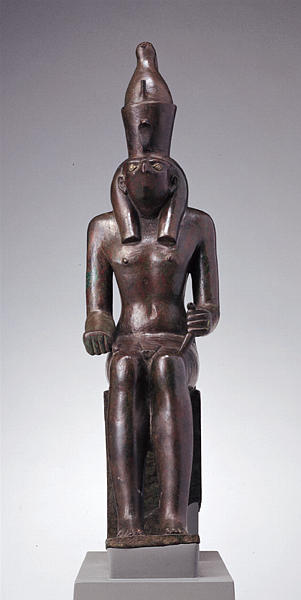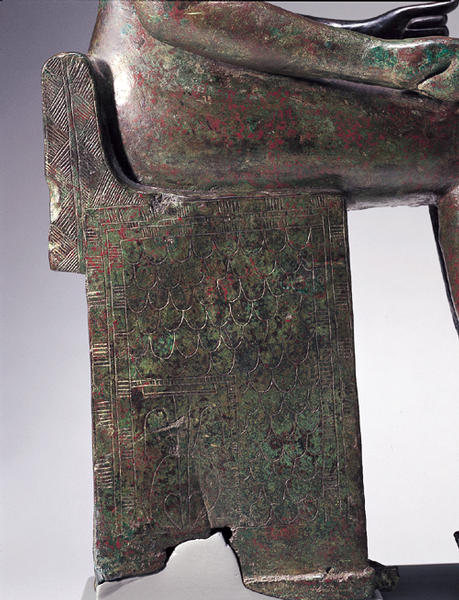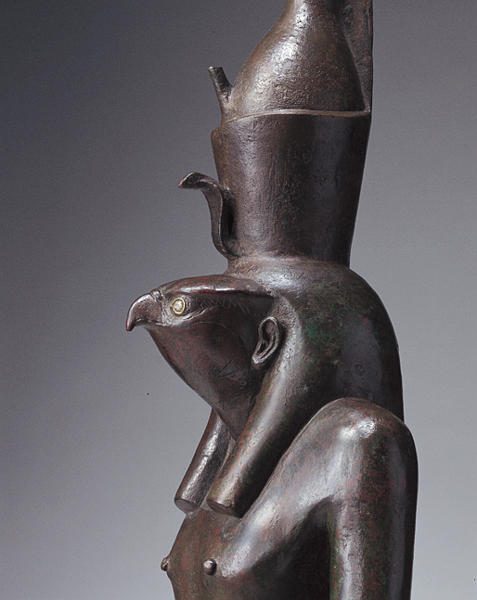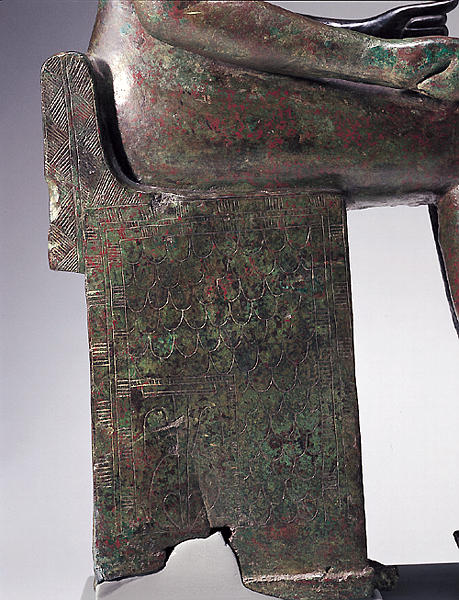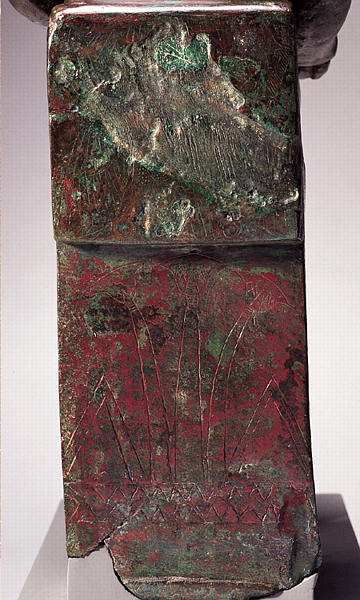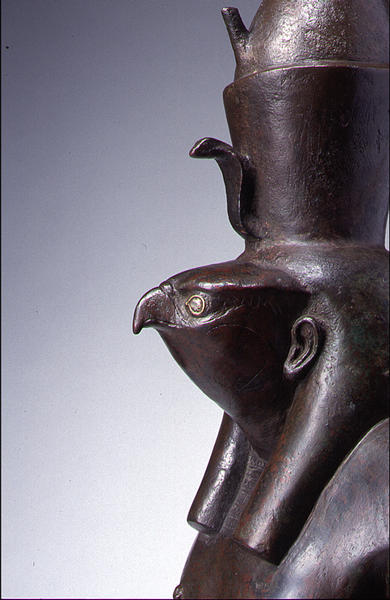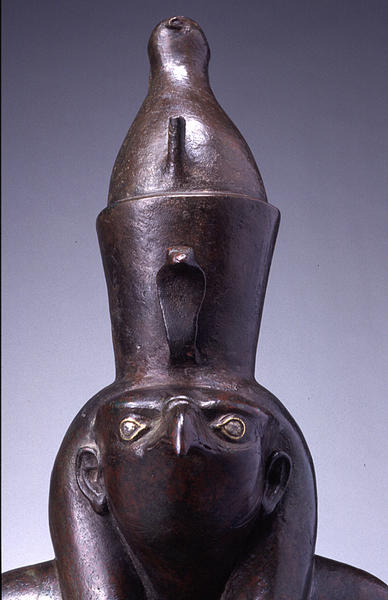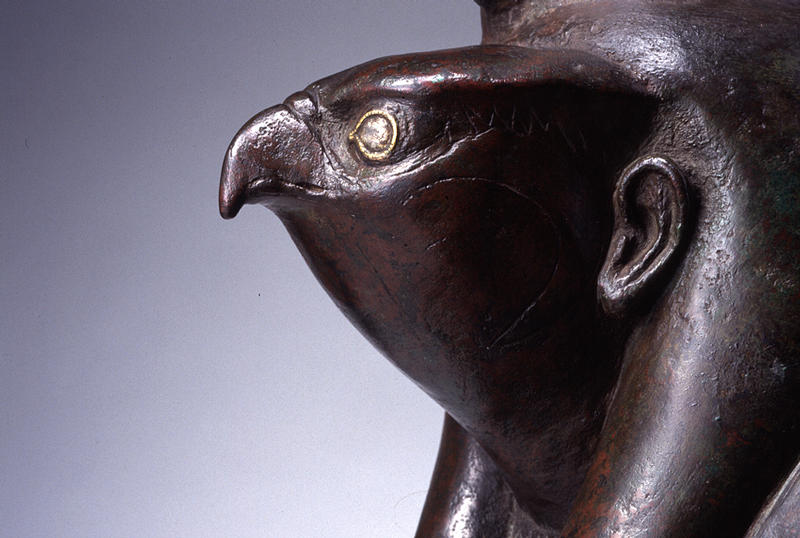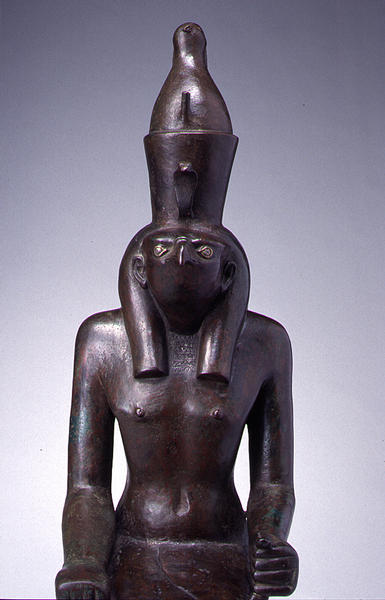Falcon-headed Deity
- Egypt
- Egypt, Late Dynasty period
- about 690 - 525 B.C.
- Sculpture, Bronze
- H-69.5 D-35 W-18.5
Catalogue Entry
This imposing sculpture depicts a falcon-headed deity, seated upon a cuboidal throne and wearing the double crown of Upper and Lower Egypt.1 It is linked by its size, technique, and iconography to a series of large bronze images discussed in the preceding entry (cat. no. 7). Presumably one of a variety of forms of the falcon god Horus, the image has human ears and a well-defined male torso.2 The treatment of the figure, with a depression forming a bipartite division of the chest descending to a drop-shaped hollow at the navel, a slim waist, and button-like nipples, is very similar to depictions of royal figures from the Twenty-sixth Dynasty, such as the figure of Psamtik I, now in the Brooklyn Museum.3
This bronze figure presents several technical details worthy of mention. The double-crown headdress has been cast separately, is hollow, and is currently attached to the head with lead solder. A tang with square cross-section that extends upward from the top of the head was originally used to secure the crown to the head of the figure.4 Most Late Period Egyptian bronzes are cast in one piece, or, if the crown is designed to be attached to the figure, it is secured with a tenon that fits into a cavity in the head of the deity.5 The eyes are inlaid with sheets of silver and encircled with an inlaid gold rim, formed to the shape of a human eye. A casting gate or support has been left in place between the proper left hand and the left knee, a detail present on several other large-scale Egyptian bronzes from this period, such as two examples now in the Sackler Museum, Harvard.6
The sides of the throne (fig. 1) have been engraved with a pattern of feathers and a sema-tawy motif. This element, formed of the heraldic plants of Upper and Lower Egypt, the lily and papyrus, tied around an anatomical unit of two lungs attached to the trachea, symbolizes the "union of the two lands," the unification of the two traditional sections of Egypt. From the Fourth Dynasty onward, this emblem underscored the king's uniting rule and was often depicted on the sides of royal thrones. The back of this throne shows a papyrus thicket emerging from a watercourse, probably an allusion to the papyrus marsh where the infant Horus was reared by his mother, Isis. The sum of the motifs depicted on the throne aid in the identification of Horus as the son of Osiris and Isis, and heavenly personification of the king, who is the ruler of united Egypt. This imagery is echoed by the headdress worn by the bronze figure, the double crown of a unified Egypt.
The image of a falcon-headed deity wearing the double crown, shown seated, standing, or grouped in combination with other deities, is known from a number of other examples.7 The closest comparison can be found in a seated bronze figure from the Twenty-sixth Dynasty capital at Sais that is now in the Egyptian Museum, Cairo.8 As in the Shumei example, that figure is seated on a cuboidal throne. The sides of the throne are engraved with another pair of rare examples of a royal offering scenes. In this case, the cartouche of King Psamtik I (r. 664-610) states that the royal figure is presenting before Horus of Pe (Buto) and the lion-headed goddess Wadjet. In addition, an inscription on the base of the statue itself identifies the figure as "Horus of Pe."9 Thus, this Shumei falcon-headed figure, like the other large bronze in the collection (cat. no. 7), is associated the image of Horus as localized in Pe (Buto), but rather than the lion-headed Horus, son of Wadjet, we have the hawk-headed Horus, representative of the king, unifier of the two lands.
NT
1. Acquired in Cairo in 1935, by Dr. A. F. Philips of Eindhoven, Netherlands, and exhibited at the Oudheid Museum, Amsterdam, in the late 1930s (note) and in Los Angeles from 1992 to 1997.
2. Areas of loss and modern restorations have altered the contours of the lower legs.
3. Bothmer 1960, p. 29, pl. 22, fig. 51.
4. Roeder 1943, p. 274-75, figs. 27-28. Roeder describes the method of attachment and provides a sketch of an attachment mechanism. However, technical examination at the Conservation Center of the Los Angeles County Museum of Art, including X-ray radiography, which confirmed the prescience of the tang, did not reveal supporting evidence for the proposed attachment mechanism. In fact, technical evidence suggests that the crown may be a replacement, either an ancient repair or an addition of a modern crown in a modern restoration procedure.
5. Reported by Roeder 1939, p. 275, another bronze image with the same method of attachment as the Shumei bronze is a figure of the crocodile-headed god Sobek, Berlin Museum 2472.
6. Arthur M. Sackler Museum, Harvard University Art Museum, no. 1943.1121a,b.
7. Roeder 1956, pp. 75-87.
8. Cairo, Egyptian Museum, no. 38598: Daressy 1905, pl. 34; and Roeder 1956, p. 75, 84.
9. Roeder 1939, p. 275
